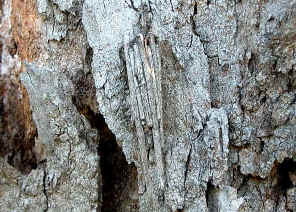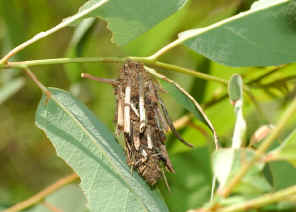|
| |
- This page contains pictures and information about Case Moths and Bag Moths that we found
in the Brisbane area, Queensland, Australia.
-
 - Case Moth larva's case
-
- Members in this family are known as Case Moths, Bagworms or Bag Moths.
The caterpillars are from small to large size. Most
species the caterpillars live in a mobile case. The case is made of silk and
plants materials or a few species mixed with grains of sand. Each species make case in different shapes. Most of them feed
on a variety of plants. When rest they stick the top opening on stem and hang
their bag vertically.
-
- The case has two openings, one at the top and other at the bottom. The
caterpillar comes out from the top to feed and ejects the waste form the bottom
end. The bottom opening, which is smaller than the top opening, is also the
exit hatch for the emerging adult. We can sometimes see the empty pupal case
left at the bottom opening of the case. We also saw once the caterpillar came
out from the bottom end when its way was stuck at the top end.
-
 
 -
- Most Case Moth caterpillars are leaf miners when they are very small.
-
- The Case Moth caterpillars may take several years before they come to the pupate stage.
We need some patient to rear the case moths. They pupate within the
case. For most species in this family, female will not develop wings
and will never come out of the bag. It just waits for a winged male inside her
bag.
-
- The adult moths are small to medium size, with relatively small eyes and
small antenna. We did not have any their photo yet.
-
-
- Leaf Case Moth, Leaf Bagworm
-
 
-
Hyalarcta huebneri, subfamily Psychinae, 50mm in length.
Young Leaf Case Moth, 10mm length
- Leaf Case Moths are common in Brisbane eucalyptus
forest. They can be found on most kind of trees, including the Eucalyptus
and Acacia. The appearance of Leaf Case Moth's case can be extremely variable.
Most information about this case moth can be found in this page.
-
-
- Ribbed Case Moth, Ribbed Bagworm
  - Hyalarcta nigrescens, subfamily Psychinae, bag length 50mm
- The bag was found hanging from gum tree leaf. Unlike other species in this
family, this Bag Moth caterpillars make their case with silk only, not using
any plant materials. All bags they made has the prominent longitudinal ribs.
More pictures and information can be found in this page.
-
-
- Smooth Case Moth

 - Oiketicus herrichii, subfamily Psychinae, bag length 50mm
- We found this Bagworm in Anstead Forest on Mar 2009. We interested in how
the caterpillar look like so we took it home and kept for a few days. We put
this Bagworm back to our backyard after taking the above photo. The
caterpillar builds smooth silk case without any decorations. Check this page
for more information.
-
-
- Saunders' Case Moths, Large Bagworm

 - Metura elongatus, (Oiketicus elongatus), subfamily Psychinae, case length 90mm
- We found the case moth caterpillar feeding on our palm tree. We have kept
it for a few weeks. It feeds at evening everyday. When disturbed it
will retreat back into its bag. It is a
large caterpillar with 10mm in cross diameter. It body is orange-brown in
colour with black eyes pattern on its thorax. We will keep it until it
turn into a moth. Please come back to this page later to see if it has turn
into a moth. For more pictures and information please also visit this page.
-
-
- Stick Case Moth
 
- Clania lewinii (former Clania tenuis), subfamily Psychinae, case length 45mm,
young case length 20mm
- This Case Moths uses sticks of similar size attached in parallel
around its silk case. We found this Case moth bag attached to a large Gum tree
trunk. The caterpillar live inside the case. They make case with sticks of
similar length. Please visit this page for
more details.
-
-
- Faggot Case Moth
  - Clania ignobilis, subfamily
Psychinae, case length 40mm
- This species makes case same as the species above except one or two
of their sticks used are much longer then the other. Click here
for more information and pictures.
-
-
- Cone Case Moth

 - Lepidoscia sp. subfamily
Taleporiinae, case length 20mm
- This caterpillar builds bag in narrow cone shape, covered with small prices
of plant materials. We found them on small gum trees during early summer in Karawatha
Forest. Please also visit this page.
-
-
- Tower Case Moth
 - Lepidoscia arctiella, subfamily Taleporiinae,
- Dec 2008, Karawatha Forest. This Case Moth larvae make elongate case
ornament with short, spirally arranged pieces of twig cut from Grevillea,
Brachyloma and other plants on which they feed. Please also check
this page for more information.
-
-
- Followings are the bag moths that yet to be identified. Please advise if you know any of
them..
-
- Log Cabin Case Moth
  - ? sp.
- Margaret Owen in Western Australia send us the about picture. We have never
seen this case moth in Brisbane. On Aug 2007 we found a mini version of the bag in Karawatha Forest. It was
less than 10mm in length, which also found on gum leaf. Please also check this
page for details.
-
-
- Wattle Case Moth

 - ?sp., Bag length 30mm
- Pictures were taken in Karawatha Forest during mid summer.

 - Bag length 15mm

 - Oct 2007, Karawatha Forest
-
-
- She-oak Case Moth

 - Case length 20mm
-
-
- Case Moth covered with thin leaves

 - Case length 20mm
-
-
- Case Moth covered with many sticks
  - Bag length 40mm
- Pictures taken in Alexandra Hill.

 - Feb 2008, found on gum leaves as well.
- This Case Moth found feeding on Eucalypt
-
-
- Case Moth covered with a few sticks

 - Mar 2008, Bulimba Creek near Wishart
-
-
-
Sand Case Moth Caterpillar attacked by Ichneumon Wasp
 - Case 50mm in length
- Living inside the case does not guarantee safety. In early spring
2003 we
found this case moth caterpillar (Leaf Case Moth)
attacked by a Ichneumon
Wasp on a Acacia tree. Although the caterpillar was inside its case bag,
which was quite useless as the prevention of wasp attack. We saw the caterpillar headed out a few times try to get rid of
the wasp but no scuess. The wasp kept on punching her long ovipositor into
the case bag for over halve an hour. This case moth species makes case out of silk and
plants materials mixed with grains of sand.
-
- Reference:
- 1. Insects of Australia and New Zealand - R. J. Tillyard, Angus
& Robertson, Ltd, Sydney, 1926, p435.
- 2. Moths of Australia
- I. F. B. Common, Melbourne University Press, 1990,
p174.
- 3. Insects
of Australia - CSIRO, Division of Entomology, Melbourne University
Press, 2nd Edition 1991, p848.
- 4. PSYCHIDAE
of Australia - Caterpillars
of Australian Moths - Don Herbison-Evans & Stella Crossley, 2007.
- 5. Case moths, bag moths or bagworms - Chris Burwell, Queensland Museum, 2006.
- 6. REVISION OF THE AUSTRALIAN PSYCHIDAE -
MEYRICK. E and LOWER O B. (1907).
[ Up ] [ Case Moths ] [ Scribbly Gum Moth ] [ Leaf Miners ] [ Concealer Moths ] [ Wood Moth, Goat Moth ] [ Leaf Rollers ] [ Sun Moths ] [ Metalmark Moths ] [ Forester Moths ] [ Pyralid Moths ] [ Crambid Moths ] [ Snout Moths ] [ Anthelid Moths ] [ Hawk Moths ] [ Unknown Moths ] [ Unknown Caterpillars ]
Back to Top
| |
|




































